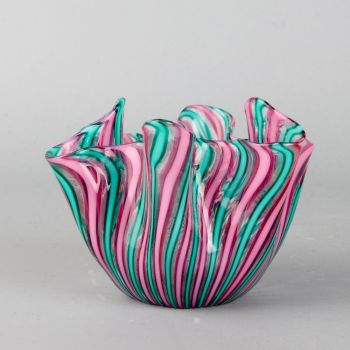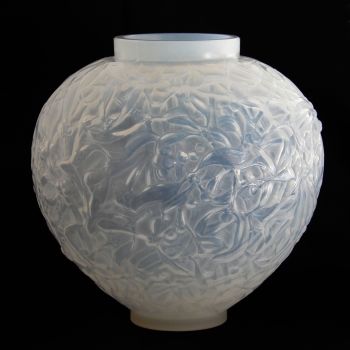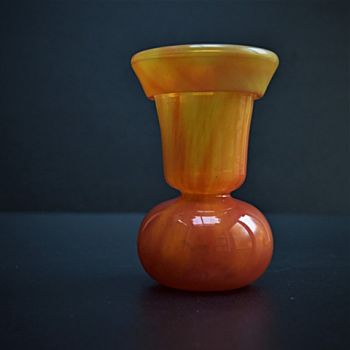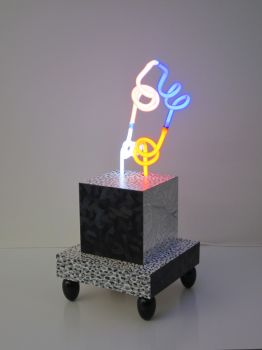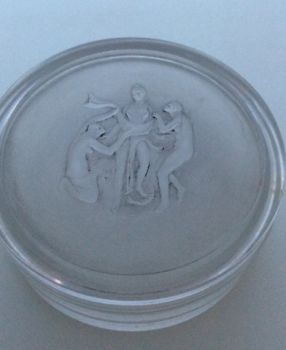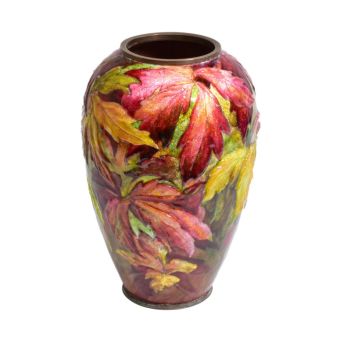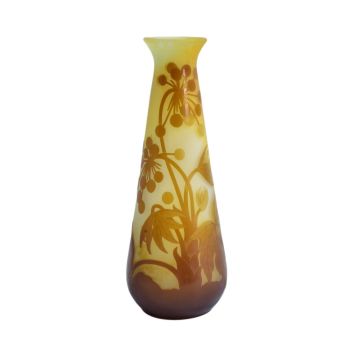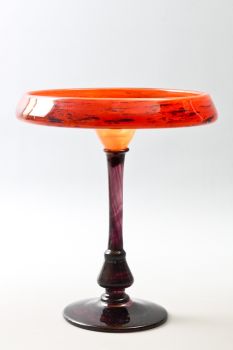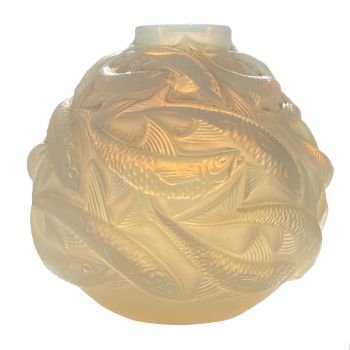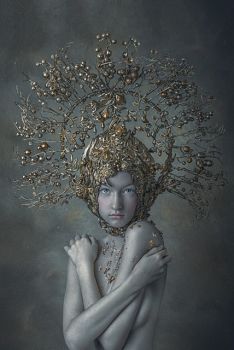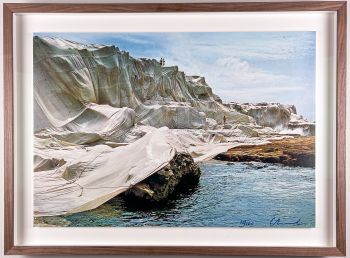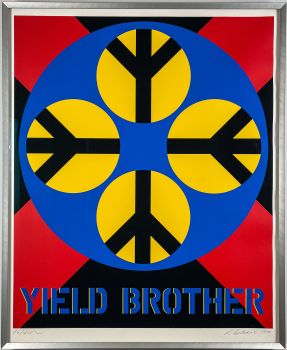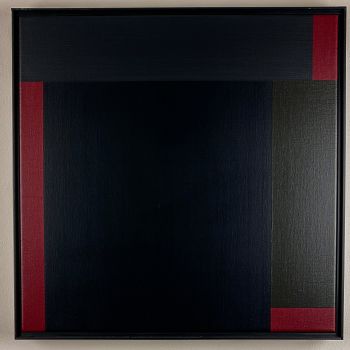A largest size glass art-object "Pajunlehti" or "Willowleaf" in unusual colour light-brown, model KF 1960 - 1965
Kaj Franck
Glas
4 ⨯ 24 ⨯ 9 cm
ConditionVery good
€ 750
Van Kerkhoff Art
- Über KunstwerkA free blown, flared, cut and polished light brown and clear cased glass art-object "Pajunlehti" or "Willowleaf", model KF 210. Designed by Kaj Franck in 1954 and executed by the Nuutajärvi-Notsjö glassworks circa 1960.
These art-objects were made in three different size-ranges and several colours between 1954 and 1963. This being a largest size example in a unusual light brown colour. The same colour used in the Nuutajärvi-Notsjö glassworks for one of the "Prisma" variants.
This Wilowleaf is etched-signed underneath the base. The etching has faded though and only K. F. remains readable. Either it was signed this way or the rest of the designers name has faded. The piece is in good condition, scratches underneath the base but no cracks or chips.
About Kaj Franck
Kaj Franck (Vyborg, Finland 1911 – Santorini, Greece 1989) was an influential Finnish designer and leading figure in Finnish art-world between 1940-1980.
Born in 1911 on the Finnish Russian border in a family of architects (his grandfather was director of the famous Arabia Ceramics factory) of Finnish-German-Swedish decent.
He attended the furniture department of Taideteollinen korkeakoulu (todays Aalto university school of Arts, Design and Architecture) in Helsinki.
After his studies he worked as a freelance designer until he joined Arabia as a designer in 1945. In 1950 he became Arabia’s Artistic Director. He also designed glass-objects for Iittala between 1946 and 1950 and between 1950 and 1976 for Nuutajärvi-Notsjö glassworks.
From 1945 onwards he worked as and educator at Taideteollinen korkeakoulu and he became the institute's Artistic Director in 1960.
His modernist designs in everyday tableware glass are considered to be a revolution and classic Finnish design object (most notably his Kilta tableware and Kartio glassware).
He is often referred to as “the conscience of Finnish design”, moderation, ecology and equality were Franck’s principles. He strove to minimise the number of everyday objects we need in our lives, drawing attention to the sustainability and life cycle of products.
Kay Franck’s designs are in collections of numerous museums all over the world. Among others: Design Museum Helsinki, Museum of Modern Art, New York, Stedelijk Museum Amsterdam and The British Museum, London. He was a recipient of many prizes. Most notably the Lunning prize in 1955, a “Grand prix” and several “Gold medals” at the Triennale di Milano.
Today his name is used for the prestigious “The Kaj Franck Design Prize” annually awarded by the Finnish Design Forum.
Execution
Nuutajärvi-Notsjö glassworks, Finland circa 1960
Marked
Etched-signed underneath the base. The etching has faded though and only K. F. remains readable. Either it was signed this way or the rest of the designers name has faded.
Condition
This art-object is in good vintage condition, some minor scratches and wear consistent with age and use. No chips or cracks.
Literature
Marianne Aav (ed.), Kaj Franck, Universal Forms, p.322
Dimensions
H. 4.9 cm
W. 24.9 cm
D. 9.8 cm
Weight 843 grams - Über Künstler
Der finnische Keramik- und Glasdesigner Kaj Franck (1911-1989) hat in seiner herausragenden Karriere eine starke Wahrheit erkannt: Einfach ist schön. Obwohl sich die Welt von einem Jahrzehnt zum anderen immer schneller bewegt, bleibt diese einfache Wahrheit bestehen. Francks Inspiration und Prinzipien begründeten eine Tradition im finnischen Design, die bis heute lebendig und stark ist. Seine bekanntesten Werke sind die Serien Iittala Teema und Kartio, und sein Erbe ist Teil jedes finnischen Zuhauses.
„Ich möchte Objekte verwenden, die so offensichtlich sind, dass sie nicht auffallen“, definierte Kaj Franck seine eigene Arbeit. Seine Entwürfe bedienten grundlegende menschliche Bedürfnisse und dienten ihnen gleichzeitig als Werkzeuge mit Eigenschaften von Alltagsgegenständen. kostenintensive Massenproduktion und gescheuter Materialismus, Wegwerfkultur und Angeberei. Francks Welt bestand aus den mathematischen Grundformen und einfachen Formen, die nur mit kräftigen Farben geschmückt waren.
Der Ausgangspunkt von Francks Arbeit war die Verbindung von Zweckmäßigkeit und Schönheit. Obwohl es heute selbstverständlich erscheint, waren seine Gedanken zu seiner Zeit radikal. Franck hat Stile und Modetrends von der Tradition getrennt und ihr eine ganz neue Bedeutung gegeben. In der Zeit von 1952-53 zeigte Franck mit der Veröffentlichung der Kilta-Serie als starkes Statement, dass Geschirr nicht übermäßig komplex sein muss – es war eine neuartige Idee, dass jeder den Tisch nach seinen eigenen Bedürfnissen decken konnte .
Franck begann seine Designs, indem er sich auf die Idee oder das zugrunde liegende Konzept konzentrierte, nicht auf die Form. Diese Betonung des ideellen Aspekts des Designs wurde auch auf seine Arbeit als Lehrer und später als künstlerischer Leiter an der Universität für Kunst und Design in Helsinki übertragen. Franck war auch einer der ersten Befürworter des Recyclings und wurde oft als „Gewissen des finnischen Designs" bezeichnet. Franck gewann in seiner herausragenden Karriere viele Preise und wurde international bekannt. Heute ist der Kaj Franck Award Finnlands renommierteste Designauszeichnung .
Sind Sie daran interessiert, dieses Kunstwerk zu kaufen?
Artwork details
Related artworks
- 1 - 4 / 10
- 1 - 4 / 24
Unbekannter Künstler
François-Théodore Legras – Tall “Fleurs de Pommier” apple blossoms vase1900 - 1909
Preis auf AnfrageAntiques Emporium
Johann Loetz (Lötz) Witwe Klostermühle
Johann Loetz Witwe - Phänomen Genre 7773 – Orange1900 - 1910
Preis auf AnfrageAntiques Emporium
Demetre Chiparus
Demetre H. Chiparus – Bronze Art Deco statue “Rapture” – Édition Etling, Paris1920 - 1929
Preis auf AnfrageAntiques Emporium
Johann Loetz (Lötz) Witwe Klostermühle
Johann Loetz Witwe – Ausfuehrung 146 Titania vase – 19121910 - 1919
Preis auf AnfrageAntiques Emporium
Frères Daum
Daum Nancy – “Paysage Soleil Couchant” vase with two applied handles1900 - 1910
Preis auf AnfrageAntiques Emporium
1 - 4 / 24Frères Daum
Daum Nancy – “Paysage Soleil Couchant” vase with two applied handles1900 - 1910
Preis auf AnfrageAntiques Emporium
Unbekannter Künstler
An Indian part-gilt silver-clad ceremonial sceptre or mace with a tiger’s head1850 - 1900
Preis auf AnfrageZebregs & Röell - Fine Art - Antiques
 Kuratiert von
Kuratiert vonDanny Bree
1 - 4 / 24- 1 - 4 / 12










































